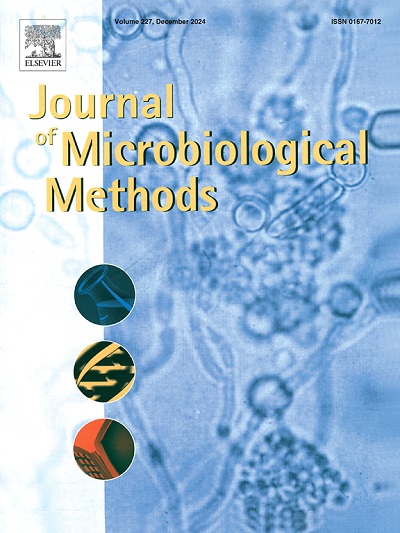双重组牛分枝杆菌卡介苗快速筛选巨噬细胞中原代和合理合成的抗分枝杆菌化合物。
IF 1.9
4区 生物学
Q4 BIOCHEMICAL RESEARCH METHODS
引用次数: 0
摘要
抗真菌筛查主要在三个层面进行;体外,离体和体内。在早期的研究中,我们在组成型和诱导型分枝杆菌启动子的控制下,产生了双重组牛分枝杆菌卡介苗菌株,携带萤火虫和Renilla荧光素酶基因作为两个报告基因。双报告酶的存在允许在一个系统内同时表达和分析两种报告酶。萤火虫荧光素酶基因的表达谱,由一个组成型分枝杆菌启动子呈现,证实了细菌生长对多种抗真菌药物的反应下降,而Renilla荧光素酶的表达增强反映了由于FAS-II通路特异性抑制而选择性诱导报告基因表达。因此,双重组菌株可以在一次试验中筛选初级和合理合成的FAS-II途径抑制剂。虽然这被成功地用于体外筛选,但这种筛选系统的体外适应提出了几个挑战。组成型hsp60pr在巨噬细胞中有明显表达,而诱导型kas操纵子启动子表达不足。这成为一个限制因素,因为每个筛选样本需要更多的杆菌数量,并且随着持续治疗,CFU水平的下降使荧光素酶测定的检测极限恶化。为了开发一种补偿巨噬细胞内特定分枝杆菌启动子低水平表达的筛选系统,我们在重组分枝杆菌中引入纳米荧光素酶报告基因。纳米荧光素酶的发光亮度是萤火虫荧光素酶和豚鼠荧光素酶的数倍,并适当地补偿巨噬细胞内kas操纵子启动子的低水平表达。新设计的双重组菌株在巨噬细胞内保持稳定,可作为一般和途径特异性抗分枝杆菌离体筛选的模型筛选系统。周转时间大大缩短,结果与使用传统的CFU方法获得的结果相似且更一致。本文章由计算机程序翻译,如有差异,请以英文原文为准。
Rapid screening of primary and rationally synthesized anti-mycobacterial compounds in macrophage using double recombinant M. bovis BCG strain
Antimycobacterial screening is done primarily at three levels; in vitro, ex vivo and in vivo. In earlier studies, we had generated a double recombinant Mycobacterium bovis BCG strain carrying firefly and Renilla luciferase genes as two reporters under the control of a constitutive and an inducible mycobacterial promoter. The presence of dual reporters allows simultaneous expression and analysis of two reporter enzymes within a single system. The expression profile of the firefly luciferase gene, rendered by a constitutive mycobacterial promoter, corroborates with the decline in bacterial growth in response to a wide range of antimycobacterial drugs, while the enhanced expression of Renilla luciferase mirrors the selective induction of the reporter gene expression as a result of FAS-II pathway-specific inhibition. Thus, the double recombinant strain allows the screening of both primary and rationally synthesized FAS-II pathway inhibitors in a single assay. While this was successfully used for in vitro screening, ex vivo adaptation of this screen-system posed several challenges. The constitutive hsp60pr showed appreciable expression inside macrophages, but the expression of the inducible kas operon promoter was found to be meager. This became a limiting factor as more number of bacilli needed per screening sample and with continued treatment the decline in CFU level worsens the detection limit of the luciferase assay. To develop a screen-system that compensate the lower level expression of a given mycobacterial promoter inside macrophages we introduced Nano luciferase reporter in recombinant mycobacteria. Nano luciferase emits several-fold brighter luminescence than firefly and Renilla luciferases and duly compensates the lower level expression of the kas operon promoter inside macrophages. The newly engineered double recombinant strain stays stable inside macrophages and serves as a model screen-system for general and pathway specific anti-mycobacterial ex vivo screening. The turnaround time is significantly reduced and the outcomes are similar and more consistent with those attained using conventional CFU based procedures.
求助全文
通过发布文献求助,成功后即可免费获取论文全文。
去求助
来源期刊

Journal of microbiological methods
生物-生化研究方法
CiteScore
4.30
自引率
4.50%
发文量
151
审稿时长
29 days
期刊介绍:
The Journal of Microbiological Methods publishes scholarly and original articles, notes and review articles. These articles must include novel and/or state-of-the-art methods, or significant improvements to existing methods. Novel and innovative applications of current methods that are validated and useful will also be published. JMM strives for scholarship, innovation and excellence. This demands scientific rigour, the best available methods and technologies, correctly replicated experiments/tests, the inclusion of proper controls, calibrations, and the correct statistical analysis. The presentation of the data must support the interpretation of the method/approach.
All aspects of microbiology are covered, except virology. These include agricultural microbiology, applied and environmental microbiology, bioassays, bioinformatics, biotechnology, biochemical microbiology, clinical microbiology, diagnostics, food monitoring and quality control microbiology, microbial genetics and genomics, geomicrobiology, microbiome methods regardless of habitat, high through-put sequencing methods and analysis, microbial pathogenesis and host responses, metabolomics, metagenomics, metaproteomics, microbial ecology and diversity, microbial physiology, microbial ultra-structure, microscopic and imaging methods, molecular microbiology, mycology, novel mathematical microbiology and modelling, parasitology, plant-microbe interactions, protein markers/profiles, proteomics, pyrosequencing, public health microbiology, radioisotopes applied to microbiology, robotics applied to microbiological methods,rumen microbiology, microbiological methods for space missions and extreme environments, sampling methods and samplers, soil and sediment microbiology, transcriptomics, veterinary microbiology, sero-diagnostics and typing/identification.
 求助内容:
求助内容: 应助结果提醒方式:
应助结果提醒方式:


